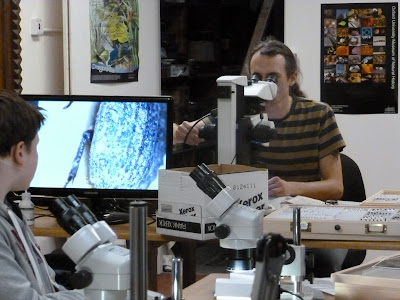We are pleased to announce that we will be hosting the BENHS for their Member's Day/AGM on the 23rd of March.
"The Society was founded in 1872 as the South London Entomological and Natural History Society and since its inception has always included amongst its members many of the leading entomologists of the day.
The objectives of the Society are the promotion and advancement of research in entomology with an increasing emphasis now being placed on the conservation of the fauna and flora of the United Kingdom and the protection of wildlife throughout the world".
The department has in the past, greatly enjoyed hosting the BENHS and other societies for a variety of different events and we hope that this occassion will be as entertaining as the others. We expect it to be a busy day, with staff dividing their time between the lecture theatre, the collections and socialising with members. We will be on hand to try and answer any questions people may have about the collections or entomology in general as well as to make sure that there is plenty of tea and biscuits avaliable to help fuel the thinking.
Details of the meeting, which is open to members and non-members alike, can be found below.
~
BRITISH ENTOMOLOGICAL &
NATURAL HISTORY SOCIETY
AGM and Members' Day Programme
Saturday 23rd March 2013
Hosted by the Oxford University
Museum of Natural History
Parks Road, Oxford, OX1
3PW
All of the meeting
is open to both members and non-members, although only members are allowed to
vote on any motions put to the AGM.
Exhibits
of live or dead insects, photos, literature, posters etc. will be most welcome.
Please display these in the lecture theatre when you arrive. They may then be
viewed and discussed during the lunch break.
Within the UK, the
Hope Entomological Collections are second in size and importance to the
national insect collection at the Natural History Museum, London. The
collection houses over 25,000 arthropod types, and comprises over 5 million
specimens. The collection includes many
specimens of great historical interest from such sources as the Hope-Westwood and
Verrall-Collin collections.
For those wishing to consult the collection during
the day, please contact the department in advance: entomology@oum.ox.ac.uk
Programme for the day
10.15 Arrive, coffee/tea, display of exhibits
10.50 Welcoming remarks and introduction to the day
11.00 Galls and their insects. Margaret
Redfern (University of Sheffield and British Plant Gall Society)
11.35 21st century insect arrivals in
the UK.
Sharon Reid (FERA)
12.10 The effects of extreme fluctuating
temperatures on aphid life history traits. Christopher Jeffs
(University of Oxford).
Student presentation
12.30 Facing up to Beetles. Michael Darby
(BENHS)
12.50 Something different. Glenda Orledge
(BENHS) Please bring a pen or pencil for this item
13.00 Lunch and viewing of exhibits (bring your own
packed lunch or forage in one of the nearby pubs or
eateries)
14.00 Society notices
14.15 Annual General Meeting with elections,
reports and Presidential Address (PTO for AGM notice)
15.00 Extreme Insects. Richard Jones
(BENHS). By special invitation of the President
15.45 Conclusion of the AGM and Tea
16.00 Tour of the entomological collections,
led by Darren J. Mann





